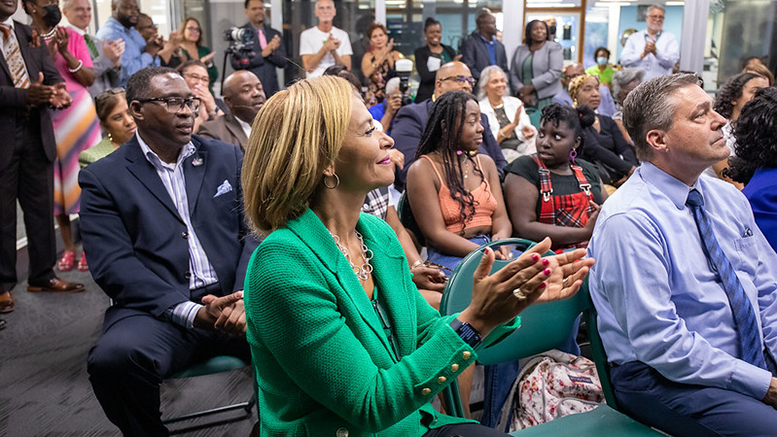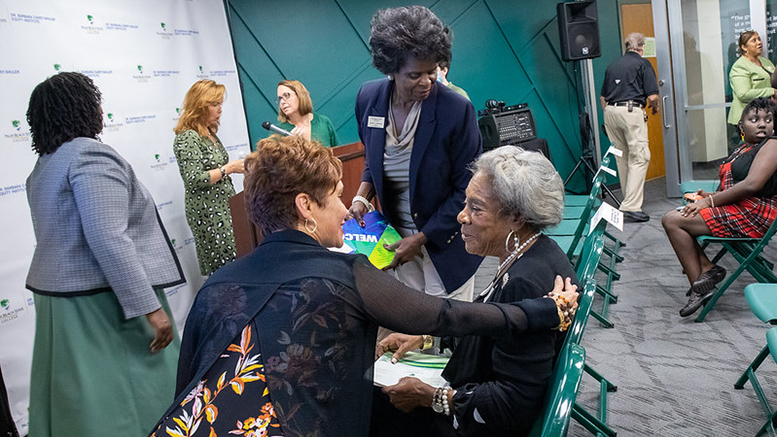Palm Beach State College (PBSC) this month opened the official home of its Dr. Barbara Carey-Shuler Equity Institute, which aims to improve retention and close the graduation gap for minority students.
The Florida college reconfigured and renovated a part of its library on its Lake Worth campus for the Equity Institute, which launched in 2020 and was named in honor of a local philanthropist whose $1.6 million investment made it possible. The institute is the first of its kind in the Florida College System.
Encased with glass windows and doors containing pictures and inspirational quotes of current and historical figures, the Equity Institute provides comprehensive support, workshops and resources to help students overcome barriers to their education and succeed.
“I don’t think that your ethnicity should determine your trajectory when it comes to an academic opportunity,’’ PBSC President Ava Parker said at the institute’s ribbon-cutting this month, recounting her conversation about the college’s various needs with Carey-Shuler at a community event in 2019. That led Carey-Shuler, a former longtime educator and Miami Dade County Commissioner who now resides in Palm Beach County, to step up to help address disparities in PBSC’s graduation rates.
Where the needs arise
“We began to talk more about it,’’ Parker recalled. “What often happens is that when you go to a university setting there will be some institute of Black culture, some institute of Hispanic culture or some office that’s designed to help level the playing field so that all students have the same opportunity. You don’t see that vision in the community college setting. So often the assumption is that because we’re an open-access institution and provide lots of support to everyone that we can just work with a cookie-cutter model. We should all finish at the same time, but that’s not what the data supports.”
Parker said with an Equity Institute, PBSC can study the data of all students, and when the data shows some students are falling behind their peers, the college can “pour into those students so that they can be on level with their colleagues.”

Currently, the graduation rate for PBSC first-time-in-college students is 41.7%. However, the graduation rate is 37.2% for Black students, while it is 44.3% for Hispanic students and 41.9% for white students. The gap is wider for Black male students, whose graduation rate is 27.1% compared to 38.8% for Hispanic males and 38.9% for white males.
The Equity Institute’s key priorities are:
- Expanding access to college through outreach initiatives.
- Increasing opportunities for students to be successful through strategic programming and services.
- Accelerating completion to keep students on track to achieve their goals.
The institute oversees three programs – Aspiring Male Panthers, Sister to Sister and NextGen Summer Bridge, a new comprehensive enrollment and retention initiative that launched this year to help first-year college students. The institute also will focus on peer-reviewed research on such topics as the Black male experience in college.
“This is special not only for the county but also for the state of Florida to have an institute like this that raises the issue of equity,’’ said PBSC board chair Carolyn Williams.
A visual impact
Carey-Shuler, who was the first African-American woman to serve on the Miami Dade County Commission and the first African-American person to serve as chair, said when Parker shared the deficiencies in retention and graduate rates for Black males especially, she had to get involved. She’s happy to see the Equity Institute come to fruition and become a model for other institutions.

“I’m excited about what has already happened and what is going to happen in the future,’’ Carey-Shuler said. “The ribbon-cutting and celebration is wonderful. What is most important is what is going to happen in this space.”
Karline Prophete, the institute’s interim director, said she also is excited about having the Equity Institute move into its physical space.
“Having a physical space is a visual representation of the commitment we have to student success,” she said. “To see this come to fruition is going to be the springboard for us executing all the goals we have and being able to do that across all five campuses.”
This article comes from the AACC 21st-Century Center.

